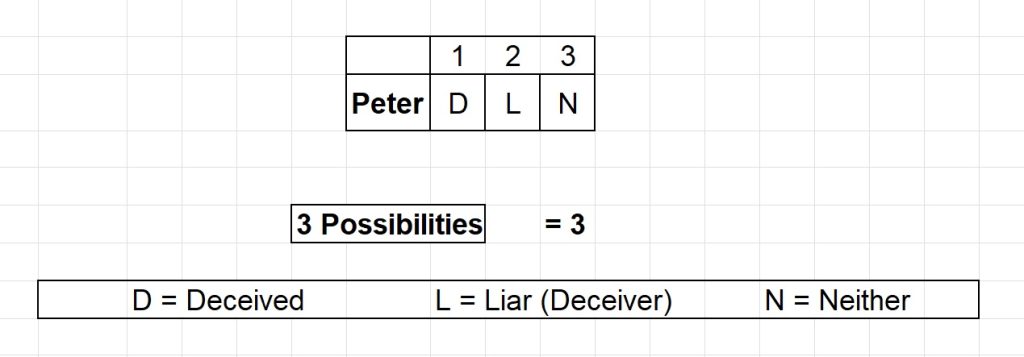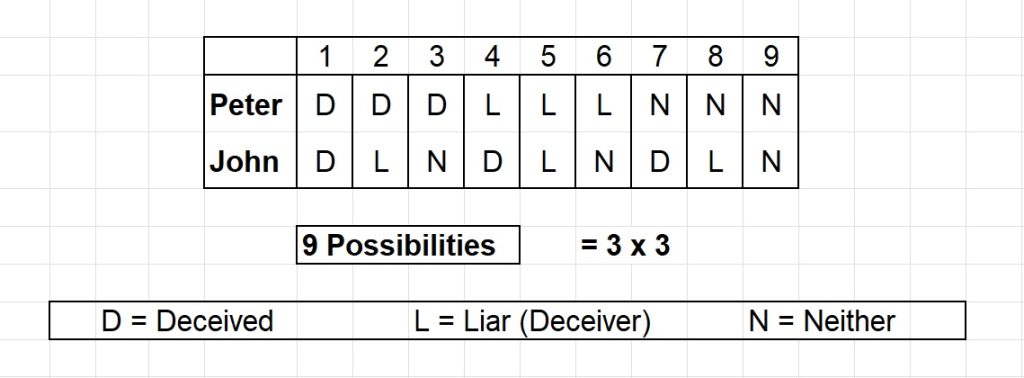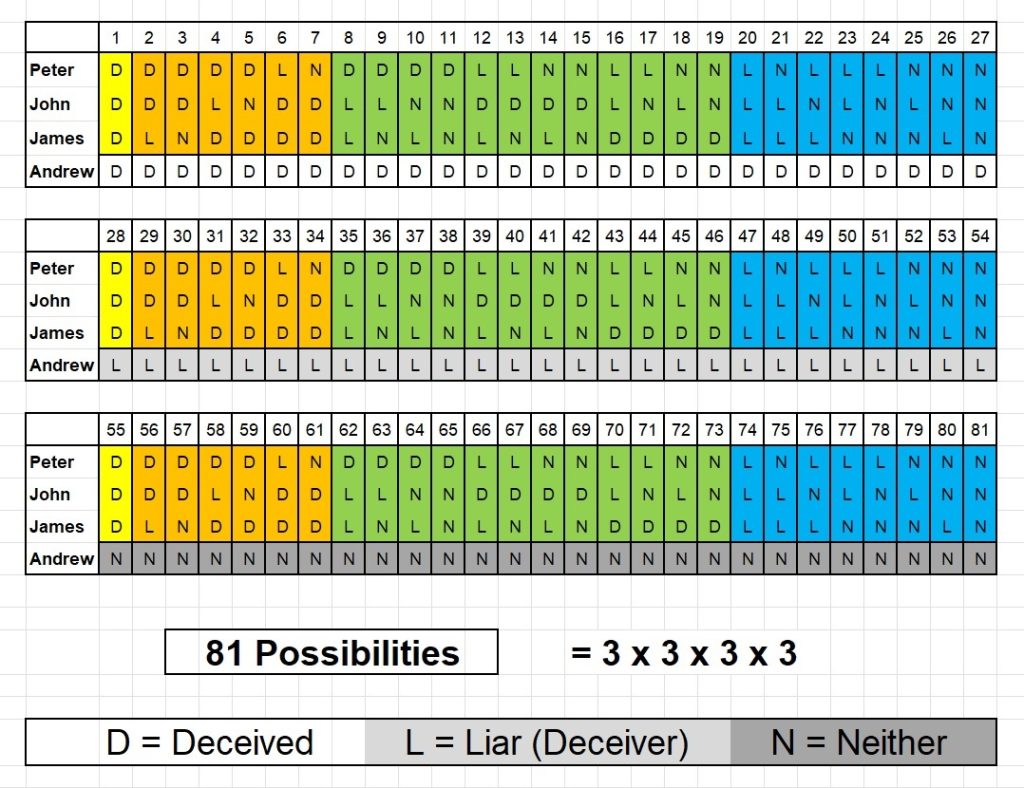How Many Skeptical Theories about the Resurrection of Jesus?
A DILEMMA IMPLIES THERE ARE ONLY TWO KINDS OF SKEPTICAL THEORIES
When Christian apologists discuss skeptical theories about the alleged resurrection of Jesus, they often think in terms of an old dilemma between the disciples of Jesus being either DECEIVED or DECEIVERS.
According to Christian apologists, Jesus’ eleven remaining disciples (the twelve minus Judas Iscariot) all proclaimed that Jesus had physically risen from the dead after he had died on the cross. So, if Jesus had NOT physically risen from the dead, then either the eleven disciples had been DECEIVED into sincerely but mistakenly believing that Jesus had risen from the dead OR the eleven disciples were DECEIVERS who did not believe that Jesus had actually risen from the dead but who lied to others and falsely claimed to have seen the risen Jesus.
This dilemma between being DECEIVED or being DECEIVERS indicates that skeptical theories about the alleged resurrection of Jesus can all be divided into these two categories.
One common skeptical theory is that the disciples of Jesus experienced hallucinations of Jesus, and these experiences led them to sincerely but mistakenly believe that Jesus had actually and physically risen from the dead. The Hallucination Theory is thus a skeptical theory that falls under the category of the disciples being DECEIVED.
Another common skeptical theory is that the disciples of Jesus invented stories about Jesus rising from the dead and appearing to his disciples after his crucifixion and burial. The disciples conspired with each other to lie to other people and pretend that they had seen the risen Jesus in order to fool other people into joining their movement. This Conspiracy Theory is thus a skeptical theory that falls under the category of the disciples being DECEIVERS.
But the Hallucination Theory is not the only skeptical theory in which the disciples were DECEIVED about the alleged resurrection of Jesus. For example, another skeptical theory asserts that Jesus only appeared to die on the cross and that Jesus was actually still alive when he was taken down from the cross. Sometime later, according to this skeptical view, Jesus met with his disciples, and this convinced the disciples that Jesus had risen from the dead. This belief was sincere but mistaken because it rested on the false assumption that Jesus had died on the cross. This Apparent Death Theory (or Swoon Theory) is a skeptical theory that falls under the category of the disciples being DECEIVED.
So, even if all skeptical theories about the alleged resurrection of Jesus can be categorized as either asserting that the disciples of Jesus were DECEIVED or that the disciples of Jesus were DECEIVERS concerning the alleged resurrection of Jesus, there are more than just two skeptical theories, because there can be more than one skeptical theory that falls under each of these categories.
DECEIVED VS. DECEIVER IS A FALSE DILEMMA
If a disciple of Jesus claimed or proclaimed that Jesus had risen from the dead but Jesus had NOT actually risen, then it seems reasonable to divide the logical possibilities about that disciple into the two categories of DECEIVED vs. DECEIVER.
However, despite the rhetoric of Christian apologists, we don’t have much information about what the eleven remaining disciples of Jesus said and did after Jesus was crucified. So, we don’t KNOW that each of the eleven disciples claimed or proclaimed that Jesus had physically risen from the dead, and that each of the eleven disciples claimed or proclaimed that he had seen and talked with the risen Jesus after Jesus was crucified and buried. Thus, it is quite possible that some of the eleven disciples did NOT believe that Jesus had physically risen from the dead and did NOT claim or proclaim that Jesus had physically risen from the dead. Such a disciple would be NEITHER a person who was DECEIVED about Jesus’ alleged resurrection NOR a person who was a DECEIVER about Jesus’ alleged resurrection.
Therefore, the traditional DILEMMA must be expanded at least into a TRILEMMA:
DECEIVED or DECEIVER or NEITHER
Now it might seem that any skeptical theory about the alleged resurrection of Jesus must assert that at least some of Jesus’ eleven disciples were DECEIVED or DECEIVERS, because if none of them claimed or proclaimed the resurrection of Jesus, it seems likely that the Christian faith, which embraces belief in the resurrection of Jesus would never have gotten started.
However, it is possible, even if unlikely, that belief in Jesus’ resurrection was claimed and proclaimed by followers of Jesus who were not among the remaining eleven disciples. Jesus supposedly had hundreds or thousands of followers beyond the inner circle of his twelve disciples. There is a possibility that belief in the resurrection of Jesus originated from followers of Jesus other than his small inner circle of disciples.
In any case, even if we set aside the possibility of a skeptical theory in which all eleven remaining disciples of Jesus were NEITHER deceived nor deceivers concerning Jesus’ alleged resurrection, we cannot set aside the possibility that some of the eleven disciples were NEITHER deceived nor deceivers.
A FALSE ASSUMPTION THAT OVERSIMPLIFIES THE ALLEGED RESURRECTION OF JESUS
Christian apologists usually make this FALSE assumption about the eleven remaining disciples of Jesus in relation to the alleged resurrection of Jesus:
Each of the eleven remaining disciples of Jesus actually saw the living and embodied risen Jesus sometime after Jesus had been crucified and removed from the cross, and they all sincerely and correctly concluded that Jesus had physically risen from the dead (i.e. the eleven KNEW that Jesus had risen from the dead),
OR
each of the eleven remaining disciples of Jesus sincerely but mistakenly believed that Jesus had physically risen from the dead, rising shortly after he had been crucified and removed from the cross (i.e. the eleven were DECEIVED),
OR
each of the eleven remaining disciples of Jesus claimed and proclaimed that Jesus had physically risen from the dead, rising shortly after he had been crucified and removed from the cross, even though they all knew this was false (i.e. the eleven were DECEIVERS).
This FALSE DILEMMA (or FALSE TRILEMMA) is based on the FALLACY OF COMPOSITION. Christian apologists mistakenly infer that the group of Jesus’ disciples must fall into one of the same three categories that each individual disciple falls into. But groups of people or things don’t necessarily fall into the same categories as the individual people or things in the group.
What these Christian apologists fail to realize is that different disciples could have had different experiences concerning the alleged resurrection of Jesus, and that different disciples could have had different beliefs or responses to their experiences concerning the alleged resurrection of Jesus.
In other words, it is possible that some disciples were DECEIVED, some disciples were DECEIVERS, and that some disciples were NEITHER. There is nothing that requires that all eleven remaining disciples had the same experiences or the same beliefs and responses to those experiences.
THREE CATEGORIES OF DISCIPLES AND THOUSANDS OF POSSIBILITIES
We should reject the FALSE DILEMMA that skeptical theories must either assume that ALL eleven remaining disciples were DECEIVED or that ALL eleven remaining disciples were DECEIVERS.
Although a specific disciple could be categorized in one of three ways (DECEIVED, DECEIVER, or NEITHER), different disciples could fall under different categories. There could have been a mix of disciples who were DECEIVED, disciples who were DECEIVERS, and disciples who were NEITHER. Once we recognize this to be the case, thousands of possibilities open up before us.
If there was only ONE DISCIPLE of Jesus, then there would only be three possibilities concerning the relation of that disciple to the alleged resurrection of Jesus:

If there were only TWO DISCIPLES of Jesus, then there would be nine possibilities concerning the relation of those disciples to the alleged resurrection of Jesus:

If there were only THREE DISCIPLES of Jesus, then there would be twenty-seven possibilities concerning the relation of those disciples to the alleged resurrection of Jesus:

If there were only FOUR DISCIPLES of Jesus, then there would be eighty-one possibilities concerning the relation of those disciples to the alleged resurrection of Jesus:

If there were ELEVEN DISCIPLES of Jesus, then there would be over one hundred seventy-seven thousand possibilities (= 3 x 3 x 3 x 3 x 3 x 3 x 3 x 3 x 3 x 3 x 3) concerning the relation of those disciples to the alleged resurrection of Jesus.
CONCLUSIONS
Christian apologists make false or dubious assumptions that OVERSIMPLIFY the possibilities about the experiences of Jesus’ disciples concerning his alleged resurrection and that OVERSIMPLIFY the possibilities about the various beliefs and responses of his disciples to those experiences.
Skeptical theories about the alleged resurrection of Jesus are NOT confined to asserting either that ALL eleven of the remaining disciples of Jesus were DECEIVED or that ALL eleven remaining disciples of Jesus were DECEIVERS.
First, there is a third skeptical possibility: Some of the eleven remaining disciples might have been NEITHER deceived nor deceivers.
Second, each of the eleven disciples could have had different experiences concerning the alleged resurrection of Jesus, and each of the eleven disciples could have formed different beliefs and responses to those experiences.
If we assume that there are just three basic possibilities for each of the eleven disciples concerning the alleged resurrection of Jesus (i.e. DECEIVED, DECEIVER, or NEITHER), then there are actually over 177,000 different skeptical possibilities, not just three possibilities.
Finally, the three basic categories (i.e. DECEIVED, DECEIVER, or NEITHER) can, and should, be divided into more specific sub-categories. For example, there is more than just ONE WAY for a disciple to have been DECEIVED about the alleged resurrection of Jesus:
- Jesus might have only appeared to die on the cross, but actually survived his crucifixion (Apparent Death Theory or Swoon Theory), leading some of his disciples to mistakenly believe that Jesus had died on the cross
- Someone who looked like Jesus might have been mistakenly identified as Jesus and mistakenly arrested and crucified as Jesus, leading some of his disciples to mistakenly believe that Jesus had been crucified
- An appearance of the “risen” Jesus to some of his disciples could have been a hallucination (Hallucination Theory), leading some of his disciples to mistakenly believe that Jesus had risen from the dead
- An appearance of the “risen” Jesus to some of his disciples could have been someone who looked like Jesus, leading some of his disciples to mistakenly believe that Jesus had risen from the dead
Therefore, there are in fact far more than 177,000 different skeptical possibilities, not just three.



